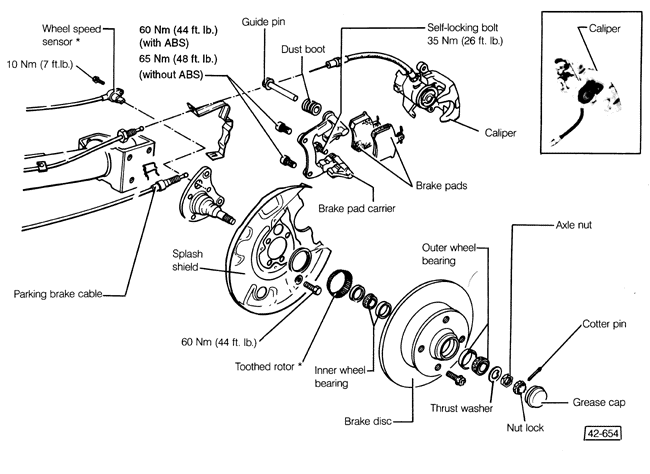7. Rear Disc BrakesThe components of the rear disc brakes are shown in Fig. 7-1. The rear disc brakes operate in much the same way as the front disc brakes described in 5. Front Disc Brakes, except that each rear disc rotor doubles as the wheel hub and wheel bearing housing. The rear calipers also serve as parking brakes, and can be mechanically activated by the parking brake cables. The wheel lug bolts attach directly to the rotor, and the inside of the rotor hub houses the wheel bearings. Two different rear disc brake calipers are used on the cars covered by this manual. The two types are very similar in function and appearance. The most obvious differences are the attachment points for the brake hose and the parking brake cable. 1985, 1986, 1987, and 1988 models through VIN -J-462562 are equipped with the earlier type. 1988 and later models after VIN -J-462562, and all ABS-equipped models use the later type. Because the rear brakes do less of the work of stopping the car, they are not likely to wear as quickly or require service as frequently as the front brakes. Unless problem symptoms are actually observed at the rear brakes, troubleshooting of brake problems should always include the front brakes. If the rear brakes are worn and require service, then at the very least the front brakes should also be thoroughly inspected. The brake pads and rotors are subjected to the greatest wear, and are the components most often needing attention. The brake pads are designed to be routinely replaced as they wear out. While it is possible to restore the brakes by replacing only the brake pads, full braking performance and minimum pad wear can only be achieved if the rotors are resurfaced or replaced at the same time. Removal of the brake rotors requires cleaning, repacking, and adjusting the wheel bearings during reassembly, as described in SUSPENSION AND STEERING.

|